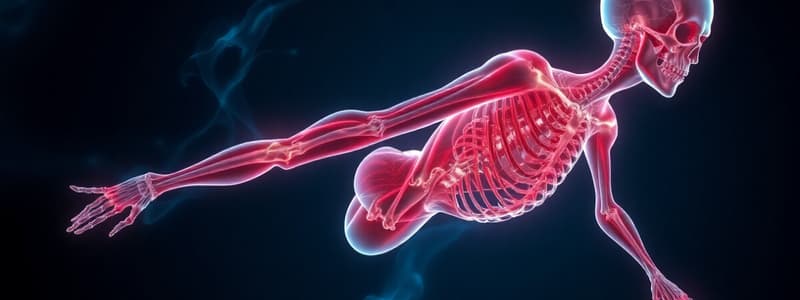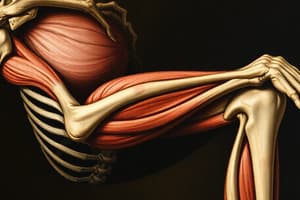Podcast
Questions and Answers
Which of the following is the type of muscle that pushes blood through the blood vessels of the cardiovascular system?
Which of the following is the type of muscle that pushes blood through the blood vessels of the cardiovascular system?
Smooth muscles are primarily used to ________.
Smooth muscles are primarily used to ________.
How many skeletal muscles are there in the muscular system?
How many skeletal muscles are there in the muscular system?
Which of the following features is NOT characteristic of muscle tissues?
Which of the following features is NOT characteristic of muscle tissues?
Signup and view all the answers
What characteristic of muscle tissue allows it to respond to stimulation by the nervous system?
What characteristic of muscle tissue allows it to respond to stimulation by the nervous system?
Signup and view all the answers
Which of the following is a function of skeletal muscle?
Which of the following is a function of skeletal muscle?
Signup and view all the answers
Why are skeletal muscles called voluntary?
Why are skeletal muscles called voluntary?
Signup and view all the answers
The layers of connective tissue surrounding a skeletal muscle from the inside to the outside in correct order are ________.
The layers of connective tissue surrounding a skeletal muscle from the inside to the outside in correct order are ________.
Signup and view all the answers
The epimysium, which separates the muscle from surrounding tissues and organs, is connected to the ________.
The epimysium, which separates the muscle from surrounding tissues and organs, is connected to the ________.
Signup and view all the answers
The connective tissue surrounding a fascicle is called ________.
The connective tissue surrounding a fascicle is called ________.
Signup and view all the answers
The attachment of a muscle to a bone is called ________.
The attachment of a muscle to a bone is called ________.
Signup and view all the answers
Which of these orders of functional muscle structures progresses from the smallest to largest in diameter?
Which of these orders of functional muscle structures progresses from the smallest to largest in diameter?
Signup and view all the answers
Actinin molecules form an open meshwork at the ________.
Actinin molecules form an open meshwork at the ________.
Signup and view all the answers
Skeletal muscle fibers arise from embryonic cells called ________.
Skeletal muscle fibers arise from embryonic cells called ________.
Signup and view all the answers
Why does a skeletal muscle fiber have more than one nucleus?
Why does a skeletal muscle fiber have more than one nucleus?
Signup and view all the answers
The complex known as the triad consists of ________.
The complex known as the triad consists of ________.
Signup and view all the answers
The sarcoplasmic reticulum is (the) ________.
The sarcoplasmic reticulum is (the) ________.
Signup and view all the answers
The portion of a sarcomere that contains the M line, H band and the zone of overlap is the ________.
The portion of a sarcomere that contains the M line, H band and the zone of overlap is the ________.
Signup and view all the answers
The structures within the muscle fiber that shorten to cause skeletal muscle fiber contraction are (the) ________.
The structures within the muscle fiber that shorten to cause skeletal muscle fiber contraction are (the) ________.
Signup and view all the answers
Delayed-onset muscle soreness is potentially caused by microscopic ruptures at the ________ of the sarcomeres.
Delayed-onset muscle soreness is potentially caused by microscopic ruptures at the ________ of the sarcomeres.
Signup and view all the answers
Study Notes
Muscle Tissue Types
- Cardiac muscle is responsible for heart contraction, pushing blood through cardiovascular system
- Smooth muscle is responsible for pushing fluid and solids through digestive tract
- Skeletal muscle is responsible for voluntary movements like walking, moving, and maintaining posture
Skeletal Muscle Characteristics
- Skeletal muscle is excitable: responds to nervous stimulation
- Skeletal muscle is contractile: generates force to shorten
- Skeletal muscle is extensible: can be stretched beyond resting length
- Skeletal muscle is elastic: returns to original length following stretch
Structure of Skeletal Muscle
- Endomysium is a thin layer of connective tissue that surrounds each muscle fiber
- Perimysium is a connective tissue sheath that surrounds bundles of muscle fibers called fascicles
- Epimysium surrounds entire muscle, attached to deep fascia
- Skeletal muscle is attached to bone by tendons, tough bands of fibrous connective tissue, or aponeuroses, broad sheets of fibrous connective tissue
- Muscle fibers contain myofibrils, bundles of myofilaments protein filaments responsible for muscle contraction
Myofilaments
- Myosin is thick filament, contains heads that bind to actin molecules of thin filaments for contraction
- Actin is thin filament, has binding sites for myosin heads
Sarcomere
- Sarcomere is the functional unit of muscle contraction, from Z line to Z line
- Z line is the point of connection for actin filaments, each sarcomere has 2 Z lines
- I band is the lightest band, ONLY contains actin filaments, situated between Z lines and A bands
- A band is the darkest band, contains BOTH actin and myosin filaments, overlapping
- H band is the lighter region within the A band, ONLY contains myosin filaments, between zones of overlap
- M line is a protein meshwork that connects adjacent myosin filaments within the H band
Muscle Fiber Development
- Skeletal muscle fibers develop from embryonic cells called myoblasts
- During development, myoblasts fuse to form multinucleated muscle fiber
- Sarcoplasmic reticulum (SR) is a specialized smooth endoplasmic reticulum that stores calcium ions, released for muscle contraction
- Transverse tubules (T-tubules) are extensions of the sarcolemma, invaginations of cell membrane, help spread muscle impulses
- Triad is formed by one T tubule and 2 terminal cisternae of the SR, these structures are responsible for transmitting impulses for muscle contraction
Muscle Soreness
- Muscle soreness is caused by microscopic ruptures in the Z lines.
Studying That Suits You
Use AI to generate personalized quizzes and flashcards to suit your learning preferences.
Related Documents
Description
Explore the different types of muscle tissue including cardiac, smooth, and skeletal muscles. Delve into the characteristics and structure of skeletal muscle, understanding its composition and function in voluntary movements.




